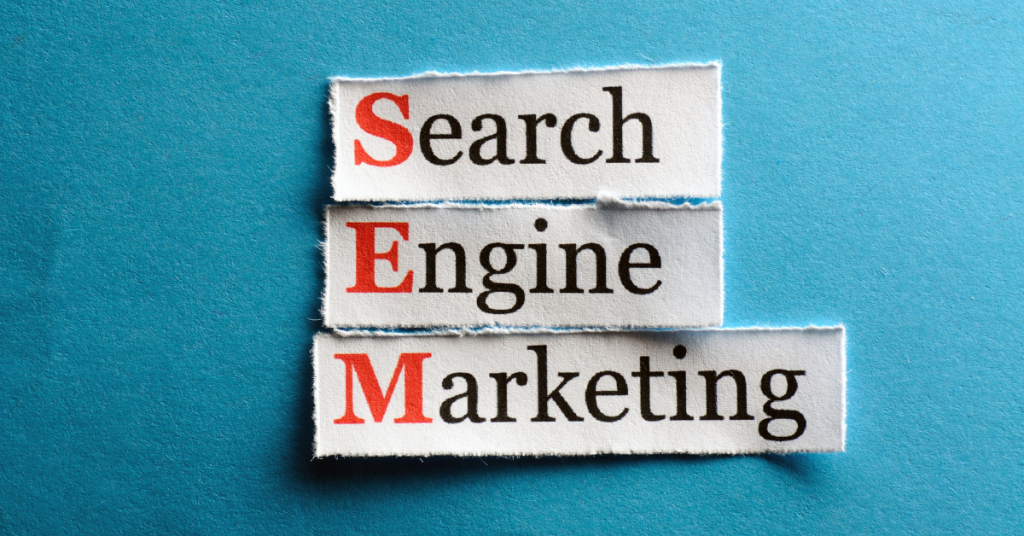In today’s digital-first world, visibility is everything. Imagine opening a new store in a bustling marketplace, but hiding it down a back alley. No matter how amazing your products are, very few people will know you exist. Similarly, online businesses need a strategic way to put themselves in front of potential customers who are actively searching for their products or services. That’s where Search Engine Marketing (SEM) comes into play. In this blog, we’ll dive deep into what SEM is, why it matters, how it differs from SEO, and how you can create high-performing SEM campaigns that deliver measurable results.
What Is Search Engine Marketing?
Search Engine Marketing, often abbreviated as SEM, is the practice of promoting websites by increasing their visibility on search engine results pages (SERPs) through paid advertising. Unlike organic search engine optimisation (SEO), where you improve your site’s ranking based on relevancy and authority, SEM relies on paid placements: those familiar “Ad” labels you see at the top or bottom of Google’s search results or Microsoft’s Bing.
At its core, SEM is about bidding on keywords that potential customers are searching for and displaying targeted ads to them. When a user types a query, say, “best digital camera under $500,” advertisers bid on those keywords so that their ad appears prominently. If the user clicks on one of these paid listings, the advertiser pays a fee, commonly referred to as Pay-Per-Click (PPC).
Why SEM Matters: SEM captures immediate demand. If someone is actively searching, they’re closer to a purchasing decision than someone passively scrolling social media. By leveraging SEM, businesses can quickly connect with prospects who have high purchase intent.
How Does SEM Work?
SEM operates on a simple yet powerful auction-based system. Here’s a step-by-step breakdown:
User Search
A potential customer enters a search query into Google, Bing, or another search engine.
Ad Auction
Search engines run an auction each time a keyword is searched. Advertisers who have bid on that keyword are entered into the auction.
Quality Score Calculation
Beyond just bid amount, search engines evaluate the Quality Score—a metric that factors in:
Expected click‐through rate (CTR)
Relevance of ad copy to the search query
Landing page experience and relevancy
A higher Quality Score can lower your cost-per-click (CPC) and improve your ad position.
Ad Rank Determination
Ad Rank is calculated using the formula:
Ad Rank = Bid Amount × Quality Score
The ad with the highest Ad Rank secures the top position on the SERP.
Ad Display
Ads are displayed in order of Ad Rank. If the user clicks on your ad, you pay the CPC bid you set (or slightly more, depending on the next highest bid).
Conversion Tracking
Once a user clicks, they land on your website (ideally a custom landing page). If they complete a desired action, such as making a purchase, filling out a contact form, or signing up for a newsletter, that’s recorded as a conversion.
By monitoring conversions, you can calculate your Return on Ad Spend (ROAS) and optimise your campaign for profitability.
Most digital marketers advocate for a combined SEM + SEO strategy. While SEO builds sustainable organic growth over time, SEM fills the gap by capturing immediate demand and driving targeted traffic right away.
Key Components of SEM
To design a successful SEM campaign, you need to understand its foundational pillars:
1. Keyword Research and Selection
Intent vs. Volume: Don’t just chase high‐volume keywords. Prioritise keywords that align with user intent and have a higher likelihood to convert (e.g., “buy running shoes online” vs. “running shoes”).
Long‐Tail Keywords: These are longer, more specific phrases (e.g., “best waterproof trail running shoes for men”). Long-tail keywords often have lower competition, lower CPCs, and higher conversion rates.
Negative Keywords: Identify terms for which you do not want your ads to show (e.g., “free,” “DIY,” “jobs”) to avoid irrelevant clicks and wasted budget.
2. Ad Auction and Bidding
Bid Strategies:
Manual CPC: You set bids for individual keywords. Best if you have time for granular control.
Enhanced CPC (eCPC): Google automatically adjusts your manual bids based on likelihood to convert.
Target CPA/ROAS: Automated bidding where you set a target cost per acquisition or return on ad spend, and Google optimises bids to meet that goal.
Ad Rank & Quality Score:
A higher Quality Score (0–10) reduces your CPC and improves ad position.
Focus on relevancy (keywords in ad copy), expected CTR, and landing page experience.
3. Ad Creative and Extensions
Compelling Headlines: Incorporate main keywords and a clear value proposition.
Ad Description: Highlight benefits, promotions, or unique selling points (USPs).
Call-to-Action (CTA): Use strong verbs like “Buy,” “Download,” “Sign Up,” or “Get Quote.”
Ad Extensions:
Sitelink Extensions: Add extra links to specific pages (e.g., “Shop Women’s Collection,” “Read Customer Reviews”).
Call Extensions: Display your phone number for mobile users.
Location Extensions: Show your business address to attract local searches.
Structured Snippets: Highlight product categories, brands, or services.
4. Landing Page Optimisation
Relevancy: The landing page must match the ad message and keywords. If your ad promises “20% off winter jackets,” the landing page headline and content should reflect that.
Speed & Mobile-Friendliness: A delay of just one second in page load time can lead to a 7% reduction in conversions. Ensure your landing pages load in under 3 seconds on both desktop and mobile.
Clear Call-to-Action: A single, prominent CTA (e.g., “Buy Now,” “Get a Free Quote”) improves user experience and conversion rates.
Trust Signals: Include testimonials, security badges, money-back guarantees, and clear privacy policies to reduce friction and reassure visitors.
Benefits of Search Engine Marketing
Immediate Visibility and Traffic
Unlike SEO, which requires time to build domain authority and rank, SEM grants near-instantaneous visibility. Once your ads are approved, they can start driving traffic within hours. This ability to capture demand quickly can be invaluable for time-sensitive promotions, seasonal sales, or new product launches.
Precise Targeting Options
Beyond keywords, SEM platforms offer granular targeting:
Geographic Targeting: Show ads only to users in specific locations—countries, states, cities, or even zip codes.
Device Targeting: Adjust bids for mobile, desktop, or tablet users based on performance metrics.
Demographic Targeting: Narrow your audience by age, gender, household income, or parental status.
Ad Scheduling: Run ads only during particular days or hours when your audience is most active.
Measurable ROI
Every click, impression, and conversion is tracked. You can see exactly which keywords, ads, and landing pages are driving sales. This data-driven approach lets you allocate budget to top-performing elements and pause underperforming ones in real time.
Budget Control
With SEM, you set a daily or monthly budget and a maximum bid for each keyword. Once your budget is exhausted, your ads stop showing. There are no surprises—your spend is predictable and controllable.
Competitive Advantage
If your competitors aren’t running SEM campaigns, you’ll appear above them on search results for high-intent queries. If they are running ads, you can strategically bid on competitor brand terms (cautiously, due to potential legal implications) or focus on long-tail, lower-cost keywords they’re missing.
Brand Awareness
Even if users don’t click on your ads, they’ll see your brand name at the top of the SERP. Over time, this improved visibility fosters trust and familiarity, which can benefit both paid and organic channels.
Steps to Launch Your First SEM Campaign
Ready to dive into SEM? Follow these five essential steps:
Step 1: Define Your Goals and Budget
Goal Setting:
Sales/Leads: Are you aiming to sell products directly, collect leads, or drive app downloads?
Awareness/Traffic: Are you raising brand awareness or simply driving visitors to your site?
Budget Allocation:
Determine your overall advertising budget (e.g., $3,000/month).
Allocate funds to different campaigns or ad groups based on priorities (e.g., 60% to product sales, 40% to lead generation).
Step 2: Conduct In-Depth Keyword Research
Tools to Use:
Google Keyword Planner: Estimate search volumes, CPC, and competition levels.
Semrush or Ahrefs (if available): Discover keyword gaps, see competitor strategies, and analyse keyword difficulty.
Google Trends: Gauge seasonal interest and trending topics.
Keyword Selection:
List broad, core terms (e.g., “digital marketing services”).
Expand into long-tail variations (e.g., “affordable digital marketing agency Singapore,” “small business digital marketing packages”).
Identify negative keywords to filter out irrelevant traffic.
Step 3: Create Compelling Ad Copy
Headline Tips:
Include the primary keyword.
Highlight a unique selling proposition (e.g., “Rank #1 on Google—Expert SEM Services”).
Use numbers or special characters (sparingly) to stand out (e.g., “Boost Sales by 150%—Start Today!”).
Description Tips:
Address pain points (“Struggling to Get Found Online?”).
Offer a solution (“Our SEM Experts Drive Targeted Traffic That Converts”).
Include a clear CTA (“Get Your Free SEM Audit”).
Ad Extensions:
Add sitelinks to drive traffic to specific service pages (e.g., “View Case Studies,” “See Pricing”).
Use callouts to highlight perks (e.g., “No Setup Fees,” “24/7 Support”).
Implement call extensions if phone calls are integral to your sales funnel.
Step 4: Set Up Your Campaign in Google Ads (or Bing Ads)
Choose Your Campaign Type
Search Network Campaign: Ads appear on Google SERPs. Ideal for capturing high-intent queries.
Display Network Campaign: Ads appear on partner websites. Best for brand awareness and retargeting.
Shopping Campaign: For e-commerce businesses selling physical products.
Video Campaign: Ads are shown on YouTube and partner video sites.
Define Campaign Settings
Locations: Target specific countries, regions, or a radius around your business.
Devices: Adjust bids or exclude devices if performance varies significantly.
Bidding Strategy: Start with Manual CPC if you prefer control, or choose Maximise Conversions (automated bidding) if you want Google to optimise for you.
Budget: Set a daily budget (e.g., $100/day). Google will pace your spend over the day.
Organise Ad Groups
Group keywords into themed ad groups—each with its own set of highly relevant ads. For instance, one ad group could target “digital marketing services Singapore,” another “SEM agency Singapore,” etc.
Ensure each ad group has 5–10 closely related keywords to maximise Quality Score.
Configure Ad Extensions
Fill out all relevant extensions (sitelink, callout, call, location). Google rewards advertisers who utilise multiple extensions with higher Ad Rank potential.
Set Up Conversion Tracking
Add the Google Ads conversion tracking code (or import Google Analytics goals).
Ensure you track meaningful actions: purchases, form submissions, phone calls, downloads, or newsletter signups.
Step 5: Monitor, Analyse, and Optimise
Regular Performance Review:
Check metrics daily or weekly CTR, CPC, Conversion Rate (CVR), Cost Per Acquisition (CPA), and ROAS.
Compare actual performance against your goals. If CPA is higher than the target, consider refining keywords or adjusting bids.
A/B Testing:
Continually test different ad headlines, descriptions, and CTAs.
Experiment with different landing page layouts, headlines, or offers to see which combination yields the highest conversion rate.
Pause Underperforming Elements:
If a keyword’s Quality Score is low and it’s draining budget, either pause it or move it to a separate ad group for deeper optimisation.
Pause ads with low CTR (<2%) and replace them with fresh variations.
Refine Audience Targeting:
Analyse demographic performance. If you see that certain age groups or locations convert better, shift the budget to those segments.
Use remarketing lists to re-engage visitors who previously visited but didn’t convert.
Optimise Landing Pages:
Use A/B testing tools (e.g., Google Optimise) to test headlines, images, form placements, and CTAs.
Improve page load speed by compressing images, minifying code, and leveraging browser caching.
Best Practices for SEM Success
Use Single-Keyword Ad Groups (SKAGs):
Instead of grouping multiple keywords, create ad groups dedicated to one keyword or very close variants. This boosts relevance, Quality Score, and CTR.
Leverage Geo-Targeting and Ad Scheduling:
If your data shows that certain cities or times of day yield higher conversions (e.g., 9 am–5 pm on weekdays), allocate more budget to those segments.
Employ Dynamic Search Ads (DSAs):
Let Google generate ad headlines dynamically based on your website content. DSAs can help you capture long-tail queries you might have missed.
Remarket to Warm Audiences:
Set up remarketing lists in Google Ads to show tailored ads to previous website visitors. People who have already engaged with your brand are more likely to convert.
Optimise for Mobile-First:
Mobile searches now account for over 60% of global search traffic. Ensure your ads, extensions, and landing pages are fully optimised for mobile users.
Monitor Quality Score Closely:
A high Quality Score not only lowers costs but also improves ad position. Focus on relevance at every layer—keywords → ads → landing pages.
Invest in Ad Copy Refreshes:
Ads can suffer from “creative fatigue.” Refresh your ad copy every 4–6 weeks to maintain a high click-through rate (CTR).
Capitalise on Ad Extensions:
Google favours advertisers who use multiple ad extensions, rewarding them with better Ad Rank. Use all relevant extensions, callouts, structured snippets, sitelinks, call, and location.
Common SEM Mistakes to Avoid
Neglecting Negative Keywords
Without negative keywords, you risk showing ads on irrelevant queries, wasting budget. Regularly check the “Search Terms” report and add negative keywords to avoid non-converting traffic.
Overlooking Mobile Experience
Running mobile-focused campaigns without checking how your landing pages perform on mobile devices can lead to a high bounce rate and lost conversions.
Ignoring Quality Score
Some advertisers focus solely on bid amounts and overlook Quality Score. Remember that improving ad relevance and landing page experience can drastically reduce costs.
Failing to Track Conversions Properly
If you haven’t set up conversion tracking accurately, you’re flying blind. Always verify that your conversion actions, such as form fills or purchases, are being recorded.
Broad Match Overuse
Relying too heavily on broad match keywords can bring irrelevant traffic. Combine broad match modifiers, phrase match, and exact match for better control.
Not Testing Ads
Running the same ad copy indefinitely leads to diminishing returns. Continuously A/B test and refine your ads based on performance data.
Measuring Success: Key Metrics and KPIs
Understanding which metrics matter and how to interpret them is crucial for optimising your SEM efforts:
Impressions: Number of times your ad was shown. Reflects overall reach.
Clicks: Number of times users clicked your ad. Indicates initial interest.
Click-Through Rate (CTR): Clicks ÷ Impressions. A benchmark for ad relevance, higher CTR often leads to better Quality Scores.
Average Cost-Per-Click (CPC): Total spend ÷ Clicks. Indicates how much you’re paying for each visit.
Conversion Rate (CVR): Conversions ÷ Clicks. Measures how effectively your landing page and funnel convert visitors.
Cost-Per-Acquisition (CPA): Total spend ÷ Conversions. Critical for ensuring your campaign is within budget and profitable.
Return on Ad Spend (ROAS): Revenue generated ÷ Ad spend. The ultimate measure of profitability for e-commerce campaigns.
Quality Score (0–10): Google’s assessment of keyword relevance, ad copy, and landing page experience. A higher score lowers your cost per click (CPC) and improves your ad rank.
Regularly review these KPIs in your Google Ads dashboard and Google Analytics to identify areas for improvement. Set up custom reports and automated alerts so you don’t miss critical performance shifts.
The Future of SEM
Search engine marketing is constantly evolving. Here are some trends shaping the future:
Automation and AI-Driven Bidding
Automated bid strategies like Target ROAS, Maximise Conversions, and Responsive Search Ads (RSAs) reduce manual workload and often deliver better results. As machine learning models improve, advertisers who embrace automation will gain a competitive edge.
Voice Search Optimisation
With voice assistants (e.g., Siri, Alexa, Google Assistant) on the rise, search queries are shifting toward conversational, long-tail phrases. SEM campaigns will need to incorporate voice-friendly keywords and ad copy.
Visual Search and Shoppable Ads
Platforms like Google Lens allow users to search with images. While still emerging, “shoppable ads” that integrate with image and video search will become increasingly important, especially for e-commerce brands.
Privacy and Data Regulation
As consumer privacy concerns grow, cookies and device IDs will become less reliable. Advertisers will need to pivot to more privacy-friendly targeting solutions, using first-party data and contextual signals.
Increased Competition and Rising CPCs
As more businesses shift ad budgets from traditional channels to digital, CPCs will continue to rise, especially in competitive industries. Advertisers must focus on optimising Quality Scores and exploring long-tail keywords to maintain profitability.
Integration with Other Channels
Holistic marketing approaches, where SEM seamlessly integrates with SEO, social media, email marketing, and content marketing, will become the norm. Cross-channel attribution models will help marketers understand the full customer journey and allocate budget more effectively.
Final Words and Next Steps
Search Engine Marketing is one of the most powerful tools in a digital marketer’s toolkit. It offers immediate visibility, precise targeting, and measurable ROI. By understanding the inner workings of SEM keyword research, ad auctions, Quality Scores, and landing page optimisation, you can craft campaigns that drive qualified traffic, generate leads, and increase sales.
Ready to Elevate Your SEM Game?
At SEOCompany.me, we specialise in data-driven SEM strategies tailored to your unique goals. Whether you’re a small business looking to expand your reach or an established brand aiming to optimise your paid search efforts, our team of SEM experts can help you:
- Conduct comprehensive keyword research to uncover high-converting opportunities.
- Write persuasive ad copy and design conversion-focused landing pages.
- Implement advanced bid strategies and audience targeting for maximum ROI.
- Continuously monitor, analyse, and optimise campaigns for sustained growth.
Contact us today for a free SEM audit and discover how we can help you outpace competitors, capture high-intent traffic, and grow your revenue. In the fast-paced world of digital marketing, waiting is not an option. Get started with SEM now and stay ahead of the curve.
Author
-
Manoj Negi is a digital marketing expert with over 14 years of experience in SEO, Google Ads, and performance-driven marketing. He has worked with brands like the University of Liverpool, MDIS, Mavis Tutorial Centre and Amity Global Institute, driving significant online growth. With 8+ years in the education sector, Manoj has delivered a 300% increase in leads, generated over 200,000 quality prospects, and managed a $5 million ad budget across Google Search, Display, and YouTube Ads. His data-driven strategies focus on maximizing ROI and business growth.
View all posts
 Manoj Negi
Manoj Negi



